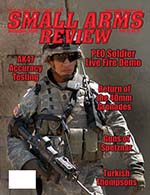By Julio Montes
Every two years the beautiful city of Rio de Janeiro hosts the Latin American Aero & Defense fair (LAAD). This year, the event combined the tri-service military show and the new Homeland Security Sector. Personnel from all armed forces, law enforcement and other security services attended LAAD. The fair highlights defense industry sectors showing growth potential in the region, homeland security, and equipment for use by armed forces on peacekeeping missions; such as personal protective equipment (helmets, flak jackets, shields, etc.), less-than-lethal weapons, and other systems for defense and security (law enforcement & homeland security).
It was not surprising to find a healthy small arms industry represented at LAAD. The Small Arms Factory from India displayed several of its products, including its own assault rifle, MAG and Carl Gustav weapons. FN displayed all its superb small arms products. Denel had some very interesting tools at hand; although this year we did not find the NTW-20. Rippel had a whole spectrum of sniper rifles in diverse calibers, along with Milkor. The Kalashnikov was also present in several exhibits from diverse countries that produce it under various designations.
The Indústria de Material Bélico do Brasil (IMBEL) is the soul of the small arms production effort in Brazil, commencing with pistol manufacturing that ranges from .45 and .40 calibers to the 9mm and .380 models, all in the traditional Colt lines. IMBEL has produced the Madsen m/46 in .45 caliber for the armed forces. The services have also taken delivery of the INA 953 SMG in .45 caliber, which is a modified Madsen m/46 with the bolt handle moved to the right side, and other improvements of the extractor and the ejector. The weapon weighs 7 lbs. 8 oz., and is fed by a 30-round magazine. The INA 953 differs very little externally from the Danish m/46, sporting the same folding wire stock and nut barrel. The standard Army rifle is the locally produced IMBEL LAR, which is simply the FN-FAL in caliber 7.62mm built under license as the M964. The LAR differs little from the Belgian model, a gas operated weapon using a tilting bolt mechanism.
The Army Technology Center (CTEX) gave us a look into the locally developed thermal sight riflescope designed for use with assault rifles or machine guns. Members of CTEX tells us that the equipment collects infrared radiation generated by heat-emitting objects, allowing night and day target sighting even in areas filled with smoke, dust or fog. The riflescope weights 1.5 kg and has a fitting compatible with MIL-STD 1913 rails. The spectra band is 8-12µm and 320x240 microbolometer. The electromagnetic compatibility is to the MIL-STD 461.
The CTEX riflescope was mounted on a MD97D mockup. This rifle traces its lineage to the IMBEL MD-1 assault rifle first developed in 1983 in 5.56mm caliber. The MD-2 model came out in 1985 and entered service in limited numbers with the Brazilian Army. These designations have been a little confusing since a locally developed submachine gun in 9mm was also designated MD-1.
The MD-2 started as a simplified variant of the LAR (Brazilian made FAL) with a few features taken from the M16. The MD-3 refers to the MD-2 equipped with a folding stock, made of plastic. The MD-2 has been replaced in production by the MD97. This newer rifle does away with the tilting block locking system of the FAL, using instead a multi-lug, rotary-bolt type. The Model 97 L was adopted in 2000 by selected Army units, and the Model LC went to the 1st Special Forces Battalion for covert operations. The MD97L operates from the familiar gas piston system. It is equipped with a folding stock for use in close quarters fighting in urban situations, and the like. It uses standard US M16 magazines and compatible large capacity drums. The body of the weapon is made from aluminum to reduce the overall weight of the weapon. The weapon fires both 3-round bursts as well as full automatic and comes in a carbine sized variant as well known as the MD97LC.
Taurus is another successful Brazilian small arms industry, and it was also prominently present at LAAD with its line of pistols and carbines. The company displayed examples of its extensive line of police products, including the Taurus-FAMAE submachine gun. This SMG comes in two variants: the MT40, and the MT9. Since the SMG is optimized for police use, the MT40 is chambered in .40 caliber and the MT9 in 9mm, and it is no other than the SAF SMG. The firing cycle is rated to a high 1,200 rpm. The Taurus-FAMAE fires from the closed bolt, and is based on components of the SIG 540 series. It uses the blowback system and an unlocked bolt. A main difference between those examples produced in Brazil and those from Chile is the folding buttstock. The Brazilians prefer the FAL style model. The Taurus products have been very successful within the various local police departments.
The company also produces the CT40 and CT30 Carbines. These are variants of the SMGs mentioned above. The CT40 uses a 410 mm barrel, measuring 890 mm with butt extended and 630 mm with butt folded. The CT30 is a neat little weapon that uses the same 15 and 30-round magazines of the US M1 and M2 carbines. The barrel measures 260 mm in length and the weapon measures a handy 785 mm with stock fully extended and 535 mm with butt folded.
This article first appeared in Small Arms Review V12N3 (December 2008) |
| SUBSCRIBER COMMENT AREA |
Comments have not been generated for this article.










